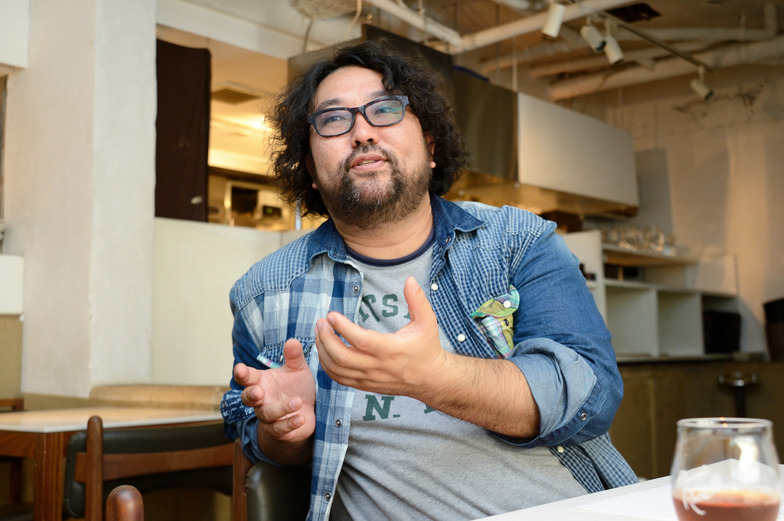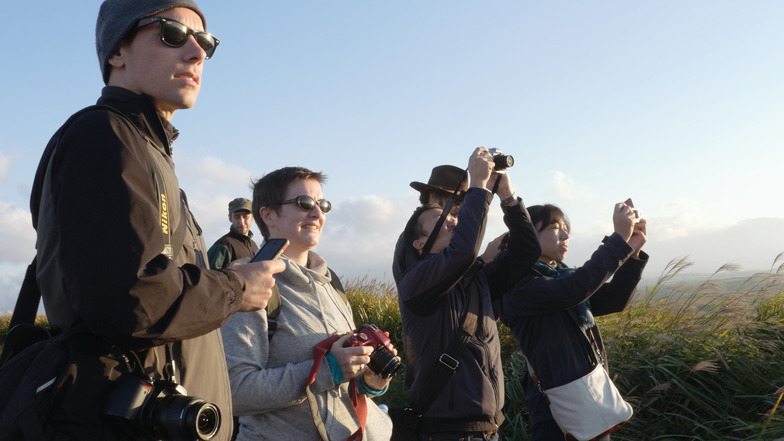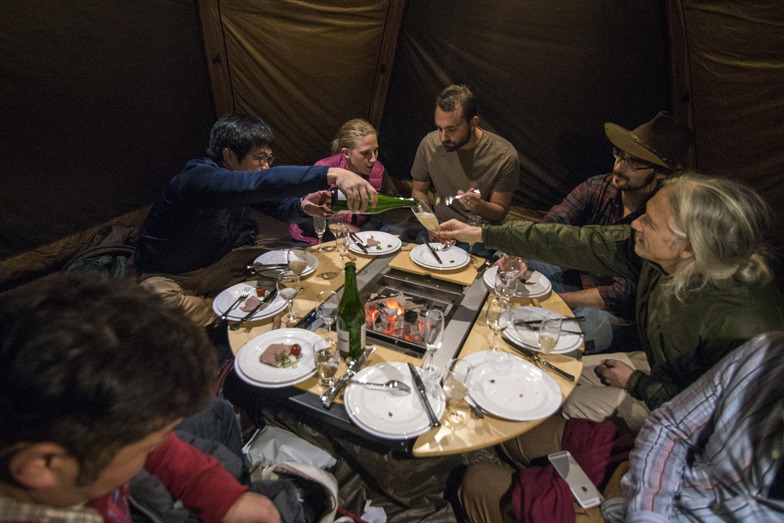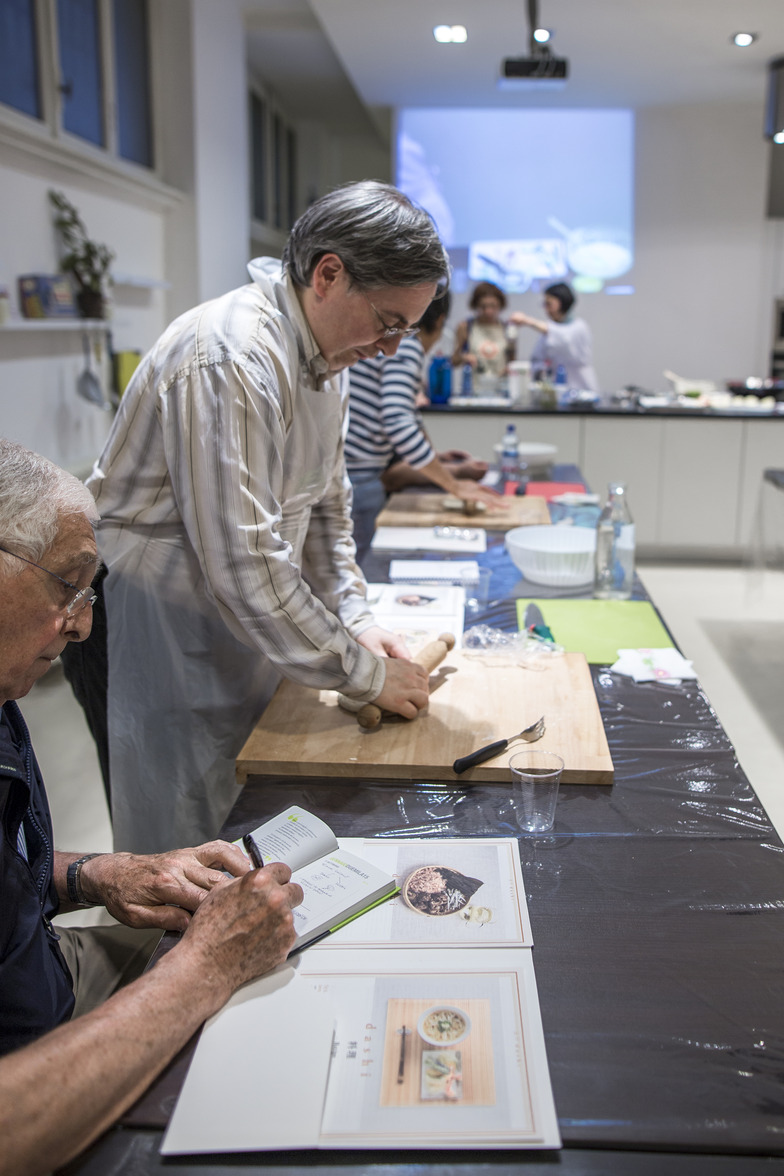The accelerating inbound business. This series features experts and Dentsu Inc.'s "Inbound Business Team" exploring the current landscape from multiple angles and introducing hints for solutions.
This time, we feature Hima Furuta, CEO of umari Inc. Known for diverse solutions that create regional value—such as Tokyo's Marunouchi Morning University, the "Like! JAPAN Project" in collaboration with Facebook, and the newly established "Furusato Meihin of the Year" in September—Mr. Furuta shares his insights on inbound tourism.

From left: Kuniyuki Takahashi (Dentsu Inc.), overseeing Dentsu Inc.'s inbound projects; Hima Furuta (umari); Takeshi Okamoto (Dentsu Inc.), working with Furuta on the "DENTSU SNOF Project" and "Kamakura Inc." projects
Creating a platform that integrates infrastructure and content
Okamoto: Mr. Furuta, we've collaborated on projects like the "DENTSU SNOF Project," which employs highly sensitive foreign producers residing in Japan who are active at the forefront of various genres to discover and communicate Japan's regional value. Beyond that, many of the other projects you handle also feature initiatives where regional revitalization and inbound tourism are closely linked.
Furuta: While inbound tourism discourse is booming lately, it tends to focus on either broad generalizations or extreme positions. It's crucial to avoid being overly constrained by the inbound context and instead prioritize creating content that captivates and engages everyone, including Japanese people, regardless of their background.
Takahashi: Mr. Murayama, the representative of Yamagokoro, also emphasized that "providing the same level of service to both Japanese and foreign visitors is crucial." "Universal" is definitely a key word here.
Furuta: We tend to focus too much on multilingual support and infrastructure for foreign visitors. But consider this: when we travel abroad and experience top-tier service at an Aman resort, we don't expect Japanese-speaking staff. What's more important is creating new, compelling content rather than relying solely on existing tourist attractions. Take New Zealand, for example. Their "adventure tourism," leveraging their natural environment—their greatest asset—has become a platform, branding the entire country. New Zealand is also where bungee jumping was first commercialized.
Okamoto: And this isn't just targeted at foreign tourists visiting Japan.
Furuta: I see Italy as a benchmark for Japan. With a population of about 60 million, half that of Japan, its food exports easily exceed 3 trillion yen, a scale completely different from Japan's roughly 500 billion yen. Furthermore, while Japan's exports are dominated by major food and beverage manufacturers, in Italy, local small and medium-sized enterprises account for about 80% of exports. They export the same wines, pasta, olive oil, and other products that tourists consume locally when visiting Italy. The value of Italy's cultivated food culture directly links to its exports. This is a crucial point. In Japan, when we talk about inbound tourism, the focus is primarily on tourism itself, which remains disconnected from exports.
Takahashi: I hear that "washoku" (Japanese cuisine) has been recognized as a World Heritage site and is booming worldwide. However, the proportion of representative Japanese ingredients in exports doesn't seem particularly high.
Furuta: "Food," as a non-verbal resource, should be Japan's greatest strength. "Omotenashi" (hospitality) is also best conveyed through food experiences. We should strive for more connections like foreigners discovering the appeal of Japanese sake in Japan and then drinking it regularly back home.
In Madrid, Spain, there's a program called the "Madrid Food Tour." If you choose the full course, you might have the first course featuring Iberian pork from this restaurant, the second course paired with sherry from that bar, and the third course featuring tapas from that market. You spend about half a day walking around Madrid enjoying the full course.
For example, I think we could present Japan as one giant restaurant, with different seasonal themes. In January, you could enjoy winter yellowtail from Himi. In spring, collaborate with Kyoto kaiseki restaurant Kitcho to go bamboo shoot foraging in Arashiyama and savor them at the restaurant.
Okamoto: Even if you're not a foreign tourist visiting Japan, you'd just want to go. (laughs)
Furuta: Another crucial point is that in regional areas, no matter how great the content you create, people can't come if there's no transportation. Content and infrastructure must always be considered as a set. For example, with buses, as long as there are roads, you can go anywhere. Incidentally, a company called Willer Alliance recently launched a site enabling one-stop booking and purchase of local routes like express buses and ferries nationwide. They've also started operating the "Kyoto Tango Railway" by taking over from a third-sector company, aiming to network various transportation options. This is extremely important for foreign tourists visiting Japan.
Okamoto: Since this functions as a platform, you can keep expanding indefinitely by changing the content.
Furuta: Creating a common platform that spans regions, and then building content for each specific area on top of that. It's crucial to push this through to the very end. However, it's unrealistic for a single municipality to build a platform from scratch.
Visualizing regional interests and cultivating value through a private-sector business perspective
Furuta: Attempting regional revitalization solely through "local" efforts has inherent limitations. Municipalities operate on individual budgets, inevitably leading to a narrow, region-specific focus. Furthermore, to establish this as a viable business, it's better handled by private organizations with the necessary expertise. Effective measures can be realized when operations are managed with solid decision-making authority, independent of administrative budgets.
Okamoto: The Kumano Tourism Bureau in Tanabe City, Wakayama Prefecture is well-known for operating not only as a city-commissioned entity but also as a general incorporated association engaged in the travel industry. Could the project in Kamakura, where Dentsu Inc. is also collaborating, become another model case?
Furuta: In Kamakura, a place with deep history and strong regional brand power, the local Chamber of Commerce and Industry and the Tourism Association joined forces to establish "Kamakura Inc." They aim to create a new model: operating on the same playing field as regular companies while giving back to the community. The goal is to solve regional issues using the public asset that is "Kamakura," but since it doesn't rely on taxes, its activities aren't constrained. We call this a "Public Interest Corporation = Public Venture."
Here, we're leveraging Kamakura's regional value as a "privilege." The term "privilege" might sound shady, but that's only because it's hidden and hard to see. We need to make it clearly visible and actively utilize it. Before putting on makeup for foreigners, you need to be naturally beautiful first. For that, ensuring blood flow—meaning the liquidity of money—is crucial.
Takahashi: Even so, locals often don't realize how much potential their area holds.
Furuta: Regional value is often invisible from the inside. A major U.S. fund acquired Odaiba's "Oedo Onsen Monogatari," but I feel Japanese people haven't fully grasped its value. Right now, foreign capital is pouring into various regions across Japan. Even in Tokyo's suburbs, foreign investment is revitalizing station buildings constructed during the bubble era that had fallen into disuse, bringing people back. This, in turn, raises the overall value of the area. Investments are being made with a clear understanding that value will inevitably rise over time. The perspective of social impact, co-creating regional value as a business model, is becoming extremely important now.
Okamoto: An external business perspective uncovers value that was invisible from within, leading to long-term, multifaceted connections for building the region's future.
Furuta: For example, trying to innovate within existing soccer frameworks has its limits. But creating a new sport allows you to establish new rules. Interesting initiatives often start from gatherings of individuals pursuing their own ideas, so the initial group formation is crucial. Involving companies is also vital. Many corporations show strong interest in regional revitalization, and we're seeing a trend of increased spending in related areas.
Takahashi: Furthermore, there's a need for people who are truly committed to tackling regional revitalization seriously.
Furuta: Ideally, we'd systematically cultivate such talent through institutions like schools. For instance, targeting individuals over 25 with at least five years of work experience, providing them with a solid year of training to acquire management skills and enable them to contribute to their region. The key isn't creating jobs, but developing people who can generate employment.
Networking foreigners who know Japan well
Furuta: New forms of tourism also change how money is made. In the New Zealand example mentioned earlier, a bungee jump costing around ¥20,000 is profitable as part of a program. But in Japan, for now, it's mostly just inns, lodging, and meals. Tourism entrance fees are negligible.
Okamoto: In successful local business creation cases, like Ross Findlay from Niseko Adventure Center (who also collaborates on the "DENTSU SNOF Project") or Brad Towle from the Tanabe City Kumano Tourism Bureau, many foreigners are involved.
Furuta: There's a huge gap between what Japanese people assume about inbound tourism and what foreigners actually want. So many things only become visible when pointed out from a foreigner's perspective.
Takahashi: Time Out's Editor-in-Chief Fushitani also mentioned that overseas editors were moved by what they discovered through their own independent reporting, rather than following set tourist routes, and declared Japan a treasure trove of content. The "DENTSU SNOF Project," which we are collaborating on, is precisely an initiative focused on the "foreign perspective," employing foreign residents in Japan as producers to cultivate regional value.
Furuta: There are many foreigners active on the front lines scattered throughout Japan's regions. Many have integrated into local communities, and connections among foreigners themselves are often weak. They possess tremendous influence when communicating back to their home countries. For example, when we tourists visit Mexico, we often rely on information from Japanese people who've lived there for 20 years more than from locals, right? It's the same for people from any country—they naturally turn first to information from people speaking a language close to their own.
Okamoto: In the "Japan National Park Expedition" project with the Ministry of the Environment, which paved the way for the "DENTSU SNOF Project," foreign producers and local key figures collaborated to develop inbound strategies for Japan's national parks. It's already been implemented in places like Nikko and Kyushu. The process of vividly discovering attractions that locals hadn't noticed, through the eyes of foreigners, was truly impressive.
Japan National Park Expedition Project
Furuta: Cross-regional approaches and innovative concepts born from collaboration are emerging, creating the potential for regional businesses to become self-sustaining in the long term. We aim to build this into a new tourism model.
Japan has a long history of mixed cultures, with various elements entering from abroad. Major transformative periods for Japan—like the arrival of Xavier, Glover, and the Black Ships—always involved foreign influence. By appointing foreign talent as key players in regional revitalization, we sense the potential for this transformation to occur at the local level.
Takahashi: So we're truly entering such a transformative era now.
Furuta: Furthermore, I don't think we need to limit ourselves to Zainichi (ethnic Japanese). Richard Lyall of New Zealand's TANKEN TOURS, who created the Japanese edition of the Western travel guide Lonely Planet 20 years ago, still produces tours to Japan from overseas. I believe this could also serve as a model.
Why are there so many French and Italian restaurants? Because many people who love France and Italy and have lived there now reside in Japan. I think even traditional Japanese restaurants could welcome more foreigners. There are countless foreigners worldwide who lived in Japan before, taught at Japanese schools, or, though no longer residing here, have deep affection for Japan and would help if needed. We should absolutely network them. Establishing an ambassador program that certifies Japan-savvy talent and Japan fans worldwide—just creating something like that would make a huge difference.
Takahashi: The theme is definitely "food," right?
Furuta: Japanese people vaguely know that Slow Food originated in Italy, right? But overseas, when it comes to Japanese food, only sushi has really spread. We're currently expanding the "Peace Kitchen" project starting from Italy. The "Wa" in Washoku (Japanese cuisine) means peace. We want to properly convey Washoku from its underlying philosophy, and we're working on this in various places around the world, like Europe and Qatar. Yes, I believe "food" will indeed become one of the major pillars for future inbound tourism.
The "Peace Kitchen" Project












